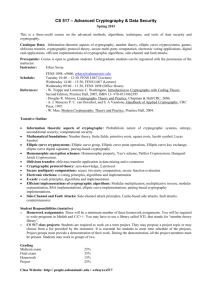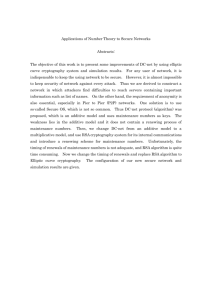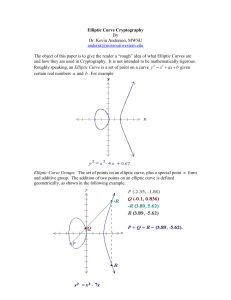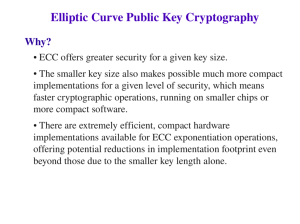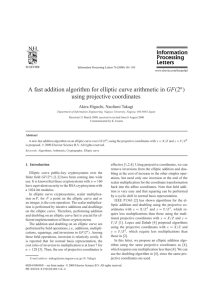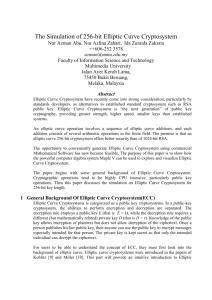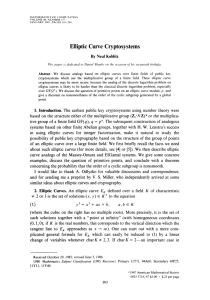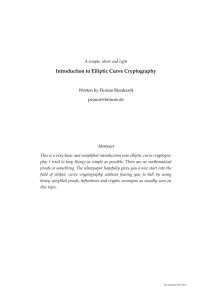Elliptic Curve Cryptography
advertisement
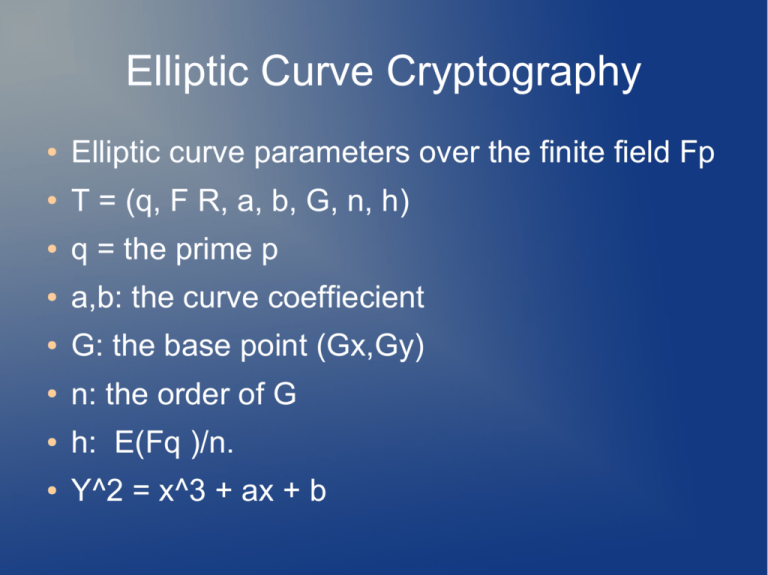
Elliptic Curve Cryptography ● Elliptic curve parameters over the finite field Fp ● T = (q, F R, a, b, G, n, h) ● q = the prime p ● a,b: the curve coeffiecient ● G: the base point (Gx,Gy) ● n: the order of G ● h: E(Fq )/n. ● Y^2 = x^3 + ax + b Elliptic Curve Cryptography (ECC) ● ● ECC depends on the hardness of the discrete logarithm problem Let P and Q be two points on an elliptic curve such that kP = Q, where k is a scalar. Given P and Q, it is hard to compute k ● k is the discrete logarithm of Q to the base P. ● The main operation is point multiplication ● Multiplication of scalar k * p to achieve another point Q Point Addition ● Point addition is the addition of two points J and K on an elliptic curve to obtain another point L on the same elliptic curve. Point Doubling ● Point doubling is the addition of a point J on the elliptic curve to itself to obtain another point L on the same elliptic curve. Point Multiplication ● ● ● ● kP=Q Point multiplication is achieved by point addition and point doubling Point addition, adding two points J and K to obtain another point L i.e., L = J + K. Point doubling, adding a point J to itself to obtain another point L i.e. L = 2J. Point Multiplication example ● ● ● ● ● Let k be a scalar that is multiplied with the point P to obtain another point Q on the curve. i.e. to find Q = kP. If k = 23 then kP = 23.P = 2(2(2(2P) + P) + P) + P As you can see point addition and point doubling are used to create Q The above method is called ‘double and add’ method for point multiplication Non-Adjacent Form and window Non-Adjacent Form are other methods Elliptic Curve Digital Signature Algorithm Signing ● For signing a message m by sender A, using A’s private key d 1. Calculate e = HASH (m), where HASH is a cryptographic hash function, such as SHA-1 2. Select a random integer k from [1,n − 1] 3. Calculate r = x1 (mod n), where (x1, y1) = k * G. If r = 0, go to step 2 4. Calculate s = k − 1(e + dr)(mod n). If s = 0, go to step 2 5. The signature is the pair (r, s) Elliptic Curve Digital Signature Algorithm Verification ● For B to authenticate A's signature, B must have A’s public key Q 1. Verify that r and s are integers in [1,n − 1]. If not, the signature is invalid 2. Calculate e = HASH (m) 3. Calculate w = s −1 (mod n) 4. Calculate u1 = ew (mod n) & u2 = rw (mod n) 5. Calculate (x1, y1) = u1*G + u2*Q 6. The signature is valid if x1 = r(mod n) Elliptic Curve Diffie Hellman ● ● ● ● a key pair consisting of a private key d (a randomly selected integer less than n, where n is the order of the curve, an elliptic curve domain parameter) and a public key Q = d * G (G is the generator point, an elliptic curve domain parameter). Let (dA, QA) be the private key - public key pair of A and (dB, QB) be the private key - public key pair of B its not possible to obtain the shared secret for a third party. Elliptic Curve Diffie Hellman Pt. 2 1.The end A computes K = (xK, yK) = dA * QB 2. The end B computes L = (xL, yL) = dB * QA 3. Since dAQB = dAdBG = dBdAG = dBQA. Therefore K = L and hence xK = xL 4. Hence the shared secret is xK ● Since it is practically impossible to find the private key dA or dB from the public key K or L Reason For Use ● Smaller key size ● Faster than RSA ● Good for handhelds and cell phones NIST Reccomend Curves ● NIST reccomends p selections of 192,224,256,384,and 521 for use in government applications Reference [1] Darrel Hankerson, Julio Lopez Hernandez, Alfred Menezes, Software Implementation of Elliptic Curve Cryptography over Binary Fields, 2000, Available at http://citeseer.ist.psu.edu/hankerson00software.html ● [2] M. Brown, D. Hankerson, J. Lopez, A. Menezes, Software Implementation of the NIST ● Elliptic ● http://citeseer.ist.psu.edu/brown01software.html ● Curves Over Prime Fields, 2001, Available at [3] Certicom, Standards for Efficient Cryptography, SEC 1: Elliptic Curve Cryptography, ● Version 1.0, September 2000, Available at http://www.secg.org/download/aid- ● 385/sec1_final.pdf ● [4] Certicom, Standards for Efficient Cryptography, SEC 2: Recommended Elliptic Curve ● Domain Parameters, ● http://www.secg.org/download/aid-386/sec2_final.pdf ● ● ● Version 1.0, September 2000, Available at [5] Openssl, http://www.openssl.org [6] Certicom, http://www.certicom.com/index.php?action=ecc_tutorial,home [7] Alfred J. Menezes, Paul C. van Oorschot and Scott A. Vanstone, Handbook of Applied


